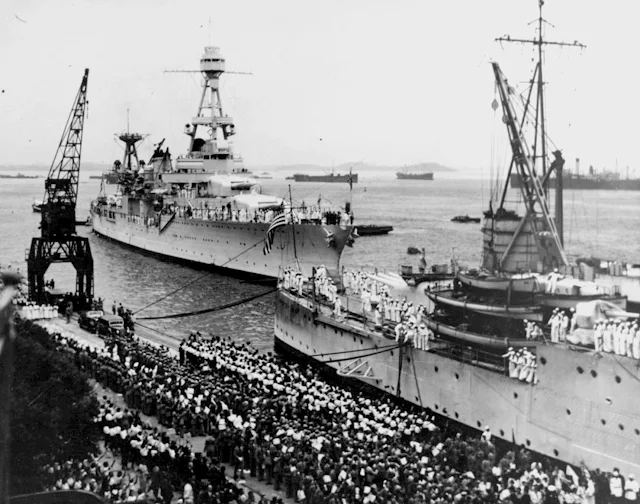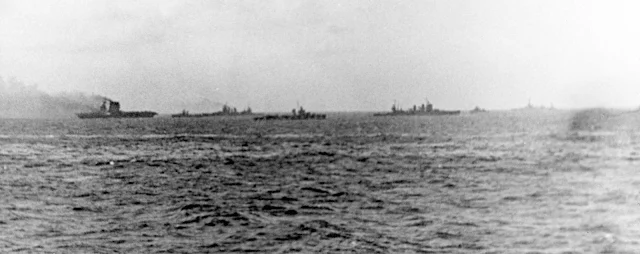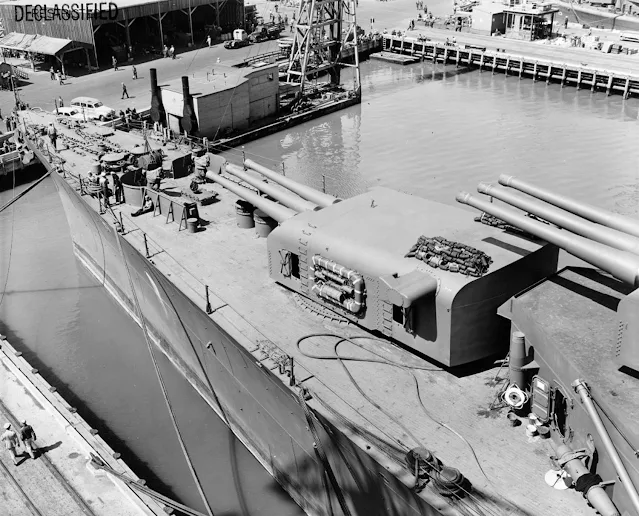 |
| USS Chester (CA-27). (Naval History & Heritage Command 19-N-14418) |
USS Chester (CL/CA-27), a Northampton-class cruiser, was the second ship of the United States Navy named after the city of Chester, Pennsylvania.
Construction and Commissioning
Chester was launched on 3 July 1929 by New York Shipbuilding Company, Camden, New Jersey; sponsored by Miss J. T. Blain; commissioned on 24 June 1930, Captain Arthur Fairfield in command; and reported to the Atlantic Fleet.
Inter-war Period
Chester cleared Newport, Rhode Island on 13 August 1930 for an extensive European cruise. She visited Barcelona, Naples, Constantinople, Phaleron Bay, and Gibraltar before returning to Chester, Pennsylvania, for voyage repairs on 13 October. She joined the Scouting Fleet as flagship for Commander, Light Cruiser Divisions, and on 6 March 1931, embarked the Secretary of the Navy for the Canal Zone where he observed the annual fleet problem from Texas. Chester carried the secretary back to Miami, Fla., arriving on 22 March, then sailed to Narragansett Bay for exercises and duty escorting two visiting French cruisers.
Originally classified as a light cruiser, CL-27, because of her thin armor. Effective 1 July 1931, Chester was redesignated a heavy cruiser, CA-27, because of her 8-inch guns in accordance with the provisions of the London Naval Treaty of 1930.
Following an overhaul at New York Navy Yard during which she was equipped with two catapults amidships, Chester stood out of Hampton Roads on 31 July 1932 with planes and ammunition for the West Coast. She arrived at San Pedro, California on 14 August and joined in the regular activities of the fleet. Departing San Pedro on 9 April 1934 as flagship of Commander, Special Service Squadron, she arrived in New York on 31 May for that day’s Presidential Naval Review, returning to San Pedro on 9 November. Ensign Richard O’Kane, who would win the Medal of Honor as the most successful United States submarine officer of World War II, served aboard Chester for one year as a junior gun division officer and then as signal officer following graduation from the United States Naval Academy in 1934. On 25 September 1935, Chester embarked the Secretary of War and his party for a voyage to the Philippines in connection with the inauguration of the president of the Philippines Commonwealth on 15 November. Returning to San Francisco on 14 December 1935, she resumed operations with Cruiser Division 4.
Sailing from San Francisco on 28 October 1936, Chester arrived at Charleston, South Carolina on 13 November and departed five days later to escort Indianapolis with President Franklin Roosevelt embarked for a good-will visit to Buenos Aires, Argentina, and Montevideo, Uruguay. Chester returned to San Pedro on 24 December. Chester remained on the West Coast for fleet exercises and training cruises to Hawaiian and Alaskan waters from 1937 except for a cruise to the East Coast for exercises and overhaul (23 September 1940 – 21 January 1941). Chester was one of six ships to receive the new RCA CXAM radar in 1940.
Homeported at Pearl Harbor from 3 February, the cruiser exercised in Hawaiian waters, and made one voyage to the West Coast with Commander, Scouting Force embarked (14 May 1941 – 18 June 1941). From 10 October to 13 November, she escorted two army transports carrying reinforcements to Manila, Philippines Islands Upon her return, she joined Northampton and Enterprise and was at sea returning from Wake Island when the Japanese attacked Pearl Harbor.
World War II
Chester remained on patrol with Task Force 8 (TF 8) in Hawaiian waters. On 12 December, her planes bombed a submarine, then guided Balch to a depth charge attack which continued until contact was lost.
1942
Chester supported the reinforcement landing on Samoa (18–24 January 1942), then joined Task Group 8.3 (TG 8.3) commanded by Adm. William Halsey for the successful raid on Taroa (1 February). Retiring under heavy air attack, she received a bomb hit in the well deck which killed eight and injured 38. The Chester was the only surface ship to lose men in the first surface attack of the Pacific war. She returned to Pearl Harbor on 3 February for repairs.
Following an escort voyage to San Francisco, Chester joined TF 17 for the Guadalcanal-Tulagi raid (4 May); the attack on Misima Island, Louisiade Archipelago (7 May); and the Battle of the Coral Sea (8 May) during which her steady antiaircraft fire protected the carriers providing the air strikes which stopped the invasion force heading for Port Moresby, New Guinea. Five of Chester ’s crew were wounded in this encounter. On 10 May, she received 478 survivors of Lexington from Hammann, whom she transferred to Tonga Island on 15 May.
After a West Coast overhaul, Chester arrived at Nouméa on 21 September 1942, to join TF 62 for the landings on Funafuti, Ellice Islands (2–4 October). She then proceeded south and while cruising in support of the operations in the Solomons, specifically north of the New Hebrides Islands, Chester was hit by a torpedo from I-176 on the starboard side, amidships on 20 October which killed 11 and wounded 12. She returned to Espiritu Santo under her own power for emergency repairs on 23 October. Three days later, President Coolidge struck a mine, and Chester sent fire and rescue parties to her aid as well as taking on the 440 survivors for transfer to Espiritu Santo. She steamed to Sydney, Australia on 29 October for further repairs and on Christmas Day, departed for Norfolk and a complete overhaul.
1943
Returning to San Francisco on 13 September 1943, Chester operated on escort duty between that port and Pearl Harbor until 20 October. On 8 November, she cleared Pearl Harbor for the invasion of the Gilbert Islands. On 18–20 November, after air attacks, destroyers and cruisers bombarded Tarawa. Chester was the lead ship and received some accurate fire from the beach the first two days. The Chester, along with the rest of the division, also bombarded Apemoma, another of the Gilberts. She covered the landings on Abemama Island and bombarded Taroa, Wotje, and Maloelap.
1944
Chester assumed antisubmarine and antiaircraft patrol off Majuro until 25 April 1944, when she sailed for San Francisco and brief overhaul (6–22 May). She joined TF 94 at Adak Island, Alaska on 27 May for the bombardments of Matsuwa and Paramushiru in the Kuriles on 13 June and 26 June, then sailed to Pearl Harbor, arriving on 13 August.
Chester sortied on 29 August with TG 12.5 for the bombardment of Wake Island (3 September), then arrived at Eniwetok on 6 September. She cruised off Saipan and participated in the bombardment of Marcus Island on 9 October, before joining TG 38.1 for the carrier strikes on Luzon and Samar in support of the Leyte operations, as well as searching for enemy forces after the Battle for Leyte Gulf (25–26 October).
1945
From 8 November 1944 to 21 February 1945, Chester operated from Ulithi and Saipan in bombardment of Iwo Jima and the Bonins, supporting the invasion landings of 19 February.
After another West Coast overhaul, Chester returned to Ulithi on 21 June, and conducted patrols off Okinawa from 27 June, as well as covering minesweeping operations west of the island. In late July, Chester was assigned to the force supplying air cover for the Coast Striking Group (TG 95.2) off the Yangtze River Delta and protecting minesweeping. In August, she made a voyage to the Aleutians, and on the last day of the month sailed to participate in the occupation landings at Ominato, Aomori, Hakodate, and Otaru in September–October.
Post-war
Chester embarked homeward bound troops at Iwo Jima, and sailed on 2 November for San Francisco, arriving on 18 November. She made another voyage to Guam to bring home servicemen (24 November – 17 December), then steamed on 14 January 1946 for Philadelphia, arriving on 30 January.
Chester was placed out of commission in reserve in Philadelphia on 10 June. She was sold for scrap on 11 August 1959.
Awards
Chester received 11 battle stars for World War II service.
Name: Chester
Namesake: City of Chester, Pennsylvania
Ordered: 18 December 1924
Awarded: 13 June 1927
Builder: New York Shipbuilding Corporation, Camden, New Jersey
Cost: $10,815,000 (contract price)
Laid down: 6 March 1928
Launched: 3 July 1929
Sponsored by: Miss J. T. Blain
Completed: 13 June 1930
Acquired: 23 June 1930
Commissioned: 24 June 1930
Decommissioned: 10 June 1946
Reclassified: CA-27, 1 July 1931
Struck: 1 March 1959
Identification:
Hull symbol: CL-27
Hull symbol: CA-27
Code letters: NAFV
Honors and awards: 11 battle stars
Fate: Sold for scrap on 11 August 1959
Status: scrapped at Panama City, Florida
Class and type: Northampton-class cruiser
Displacement: 9,200 long tons (9,300 t) (standard)
Length:
600 ft 3 in (182.96 m) oa
570 ft (170 m) pp
Beam: 66 ft 1 in (20.14 m)
Draft:
16 ft 6 in (5.03 m) (mean)
23 ft (7.0 m) (max)
Installed power:
8 × White-Forster boilers
107,000 shp (80,000 kW)
Propulsion:
4 × Parsons reduction steam turbines
4 × screws
Speed: 32.7 kn (37.6 mph; 60.6 km/h)
Range: 10,000 nmi (12,000 mi; 19,000 km) at 15 kn (17 mph; 28 km/h)
Capacity: 1,500 short tons (1,400 t) fuel oil
Complement:
92 officers 608 enlisted (as designed)
1,100 officers and enlisted
Sensors and processing systems: CXAM radar from 1940
Armament:
9 × 8 in (203 mm)/55 caliber guns (3x3)
4 × 5 in (127 mm)/25 caliber anti-aircraft guns
2 × 3-pounder 47 mm (1.9 in) saluting guns
6 × 21 in (533 mm) torpedo tubes (removed prior to World War II)
7 × quad 40 mm (1.6 in) Bofors guns (added during World War II)
28 × single 20 mm (0.79 in) Oerlikon cannons (added during World War II)
Armor:
Belt: 3–3¾ in (76–95 mm)
Deck: 1–2 in (25–51 mm)
Barbettes: 1½ in (38 mm)
Turrets: ¾–2½ in (19–64 mm)
Conning Tower: 1¼ in (32 mm)
Aircraft carried: 4 × floatplanes
Aviation facilities: 2 × amidships catapults
Bibliography
Jane's Fighting Ships of World War II. Studio. 1989.
Fahey, James C. (1941). The Ships and Aircraft of the U.S. Fleet, Two-Ocean Fleet Edition. Ships and Aircraft.
Silverstone, Paul H (1965). US Warships of World War II. Annapolis, Maryland: Naval Institute Press.
Wright, Christopher C. (September 2019). "Question 7/56: Concerning What Radar Systems Were Installed on U.S. Asiatic Fleet Ships in December 1941". Warship International. LVI (3): 192–198. |
| USS Chester (CA-27). (Naval History & Heritage Command NH 67528) |
 |
| USS Chester (CA-27) running trials, 1930. (Naval History & Heritage Command 55113) |
 |
| USS Chester (CA-27) makes 25 knots during sea trials, circa 1929-1930. (Naval History & Heritage Command NHF-059) |
 |
| USS Chester (CA-27) fitting out ay New York Shipbuilding, Camden, New Jersey, in March or April 1930. USS Salt Lake City (CL-25) is at the top of the picture. |
 |
| USS Chester (CA-27) at anchor in Naples, Italy, during her shakedown cruise in 1930. |
 |
| The U.S. Navy heavy cruiser USS Chester (CA-27) at anchor in Hampton Roads, Virginia, November 1930. (Naval History & Heritage Command NH 64643) |
 |
| USS Chester (CA-27), July 1931. |
 |
| USS Chester (CA-27), circa 1930s. Admiral A. Burke served aboard from May 1932-April 1933. (Naval History & Heritage Command NH 124501) |
 |
| USS Chester (CA-27), pre-war, undated. |
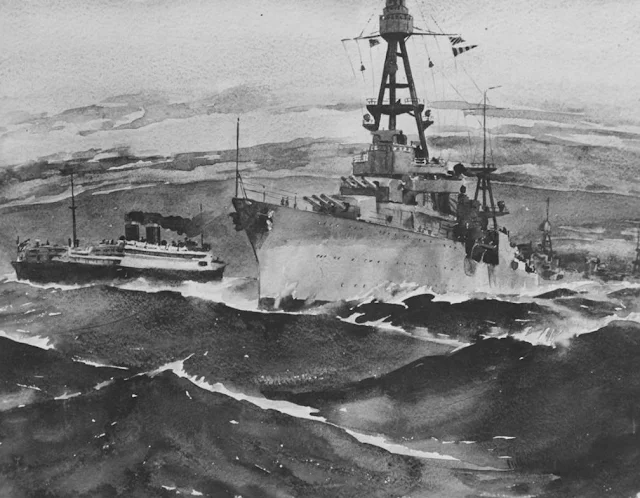 |
| USS Chester (CA-27). Watercolor painting by Lieutenant Arthur Beaumont USNRF, 1934. (Naval History & Heritage Command NH 647) |
 |
| USS Chester (CA-27) steaming in the Willamette River, Portland, Oregon, August 1936. |
 |
| Coast and Geodetic Survey Ships Guide (ex-Flamingo, AM-32) and Discoverer (ex-Auk, AM-38). Taking on fuel from USS Chester (CA-27) at Dutch Harbor, Unalaska Island, Alaska, 4 July 1939. (NOAA) |
 |
| USS Chester (CA-27), pre-war, undated. |
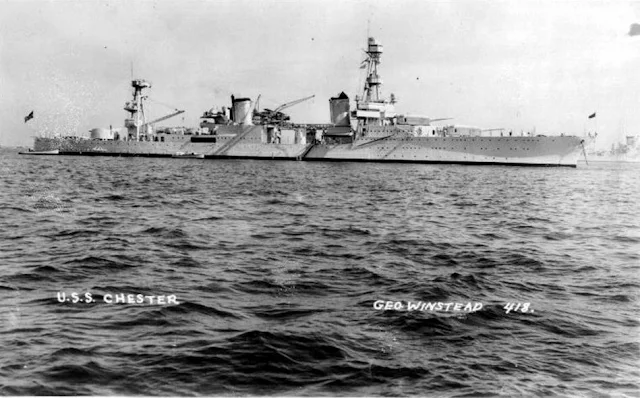 |
| USS Chester (CA-27), undated. |
 |
| USS Chester (CA-27), pre-war, location unknown. (US Navy) |
 |
| The U.S. Navy heavy cruiser USS Chester (CA-27) off the Mare Island Navy Yard, San Francisco, California, on 6 August 1942, following her first wartime overhaul. (US Navy 4592-42) |
 |
| USS Chester (CA-27) off the Mare Island Navy Yard, California, following overhaul, 6 August 1942. (Naval History & Heritage Command 19-N-32461) |
 |
| USS Chester (CA-27), plan view, starboard side, looking forward, showing alterations while at Mare Island Navy Yard, California, 6 August 1942. (US Navy) |
 |
| USS Chester (CA-27), plan view, amidships, showing alterations while at Mare Island Navy Yard, California, 6 August 1942. (US Navy 4597-42) |
 |
| USS Chester (CA-27), plan view, looking aft, showing alterations while at Mare Island Navy Yard, California, 6 August 1942. (US Navy) |
 |
| USS Chester (CA-27), plan view aft showing alterations while at Mare Island Navy Yard, California, 6 August 1942. (US Navy 4600-42) |
 |
| The U.S. Navy heavy cruiser USS Chester (CA-27) off the Norfolk Naval Shipyard, Virginia, in July 1943. (National Archives and Records Administration, National Archives Identifier (NAID) 7577453) |
 |
| USS Chester (CA-27) off The Mare Island Navy Yard, California, 15 September 1943. (*Naval History & Heritage Command NH 84581) |
 |
| USS Chester (CA-27) at Mare Island Navy Yard, California, 15 September 1943. (Naval History & Heritage Command NH 84597) |
 |
| USS Chester (CA-27) at Mare Island Navy Yard, California, 15 September 1943. (Naval History & Heritage Command NH 84582) |
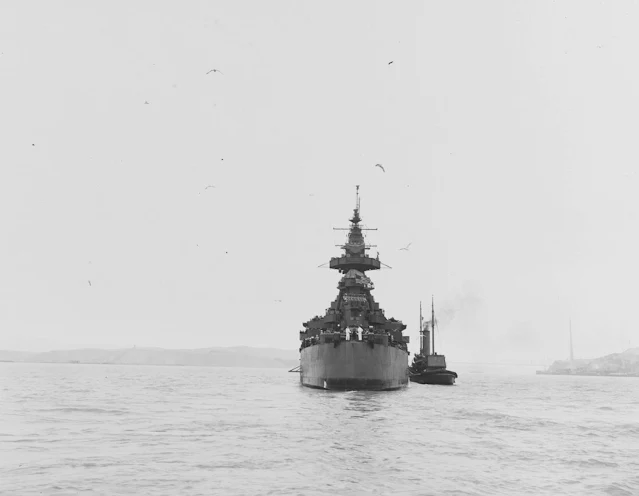 |
| USS Chester (CA-27) off The Mare Island Navy Yard, California, 15 September 1943. (Naval History & Heritage Command NH 84583) |
 |
| The U.S. Navy heavy cruiser USS Chester (CA-27) off the Mare Island Navy Yard, California, after torpedo damage repairs and overhaul, 2 October 1943. (US Navy) |
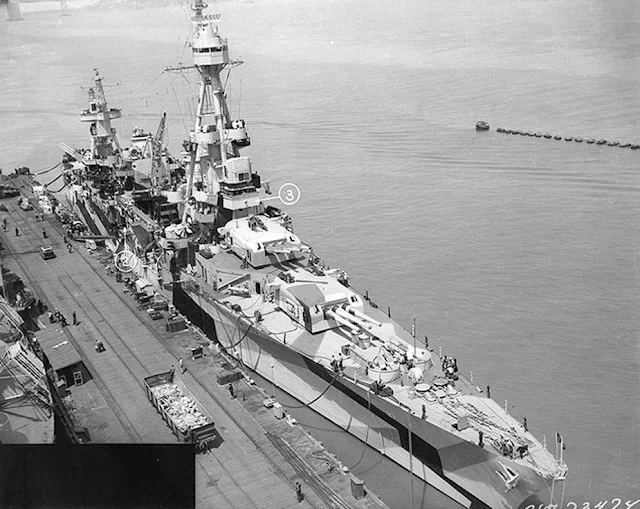 |
| USS Chester (CA-27) at San Francisco, California, following overhaul, circa late May 1944. Circled numbers mark indicate recent alterations to the ship. (Naval History & Heritage Command 19-N-73474) |
 |
| USS Chester (CA-27) off Hunter's Point, 12 June 1944 after undergoing repairs. (US Navy 1204-44-S8) |
 |
| USS Chester (CA-27) at anchor mid-1944, location unknown, but probably Adak, Alaska. |
 |
| Capt. Henry Hartley, USN while on the bridge of cruiser USS Chester (CL/CA 27) somewhere in Pacific, 20 July 1944. (US Navy) |
 |
| Battle for Iwo Jima, February-March 1945. BGM 3/C Jack Lee Gray, buglar, board USS Chester (CA 27), February 1945. (US Navy 80-G-305078 in the US National Archives) |
 |
| USS Chester (CA-27), late war, undated. |
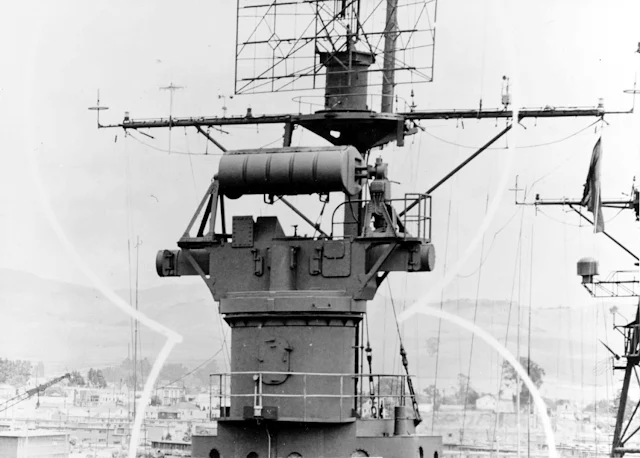 |
| USS Chester (CA-27) Mk. 13 radar antenna mounted on the forward Mk. 34 director, 13 May 1945. (Naval History & Heritage Command NH 84815) |
 |
| USS Chester (CA-27) off the Mare Island Navy Yard, 16 May 1945. (Naval History & Heritage Command 19-N-84008) |
 |
| USS Chester (CA-27) off the Mare Island Navy Yard, California, 16 May 1945, following her last wartime overhaul. (Naval History & Heritage Command 19-N-84007) |
 |
| USS Chester (CA-27) off the Mare Island Navy Yard, California, 16 May 1945. Note anchors. (Naval History & Heritage Command 19-N-84010) |
 |
| USS Chester (CA-27) off the Mare Island Navy Yard, California, 16 May 1945. (Naval History & Heritage Command 19-N-84011) |
 |
| USS Chester (CA-27) at the Mare Island Navy Yard, 13 May 1945. Circles mark recent alterations. Note 5"/25 gun. (Naval History & Heritage Command 19-N-84013) |
 |
| Aerial view of the Reserve Basin of the U.S. Navy Philadelphia Naval Shipyard, Philadelphia, Pennsylvania on 19 May 1955 with numerous ships in reserve. |
 |
| The U.S. Navy heavy cruiser USS Chester (CA-27) being towed away from the Philadelphia Navy Yard, Pennsylvania, on her way to be scrapped, circa 1959. |



